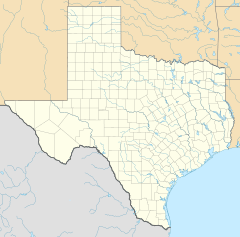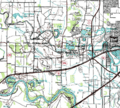Beauford H. Jester Complex facts for kids
Quick facts for kids
Harlem
|
|
|---|---|
| Beauford H. Jester Complex | |
| Country | United States |
| State | Texas |
| County | Fort Bend |
| Elevation | 79 ft (24 m) |
| Time zone | UTC-6 (Central (CST)) |
| • Summer (DST) | UTC-5 (CDT) |
| ZIP codes |
77406
|
| Area code(s) | 713, 281, and 832 |
| GNIS feature ID | 1378416 |
The Beauford H. Jester Complex is a group of prisons for men. It is located in Fort Bend County, Texas, in the United States. This area is not part of a city, so it's called an unincorporated area.
The complex includes four main prisons: Jester I Unit, Carol Vance Unit (also known as Jester II Unit), Jester III Unit, and Wayne Scott Unit (Jester IV Unit). A major road, Texas State Highway 99, goes right through the prison property. You'll see lots of cornfields around the area.
Contents
A Look Back: Its History
This complex used to be known by different names, like Harlem or the Harlem Prison Farm. The state of Texas bought this land a long time ago, around 1885 or 1886. Before that, it was made up of several large farms called plantations.
Early Days and Changes
These plantations used a system called "convict leasing." This meant that private companies would rent out people who were in prison to work on their farms. The state didn't have many prisons back then. This system was not fair because the companies had too much control over the workers.
In 1885, the state opened two of the prison units, Harlem I Unit and Harlem II Unit. For many years, there was even a post office right on the prison farm. It handled mail for the farm from 1888 to 1907. After it closed, the post office in Richmond, Texas took over.
In 1908, the state bought another nearby farm, the Riddick Plantation. This land was then added to the Harlem Farm.
A Difficult Past Incident
In September 1913, something very sad happened at one of the units. Some prison guards put twelve prisoners into a small, enclosed space. This space was about 9 feet long, 7 feet wide, and almost 7 feet high. It was called "The Hole."
The temperature inside "The Hole" became extremely hot, over 100 degrees Fahrenheit (about 38 degrees Celsius). The prisoners asked to be let out, but the guards did not open the enclosure. Tragically, eight of the twelve prisoners died because of the heat and lack of air. This was a very harsh and unfair way to treat people.
Growing and Renaming
In 1925, the prison farm covered a huge area of about 5,005 acres (about 2,025 hectares). At that time, it held 260 prisoners. In the 1950s, the complex was renamed after Beauford H. Jester, who was the Governor of Texas.
There was once a special train track that went to the prison farm. It was used to load and unload sugarcane grown there. This train line closed down in 1929.
Over the years, the state added more facilities. Jester III Unit opened in July 1982. Later, Jester IV Unit opened in November 1993. In 2021, Jester IV Unit was renamed the Wayne Scott Unit.
Jester in Movies
The Beauford H. Jester Complex was even featured in a movie! Steven Spielberg's first movie shown in theaters, called The Sugarland Express (1974), was partly filmed at this prison complex.
Gallery
-
Aerial view of the Jester State Prison Farm, January 27, 2002, from the U.S. Geographic Survey
-
Topographical map of the Jester Prison Farm, the Central Prison Farm, and Sugar Land Regional Airport, July 1, 1990, from the U.S. Geological Survey




